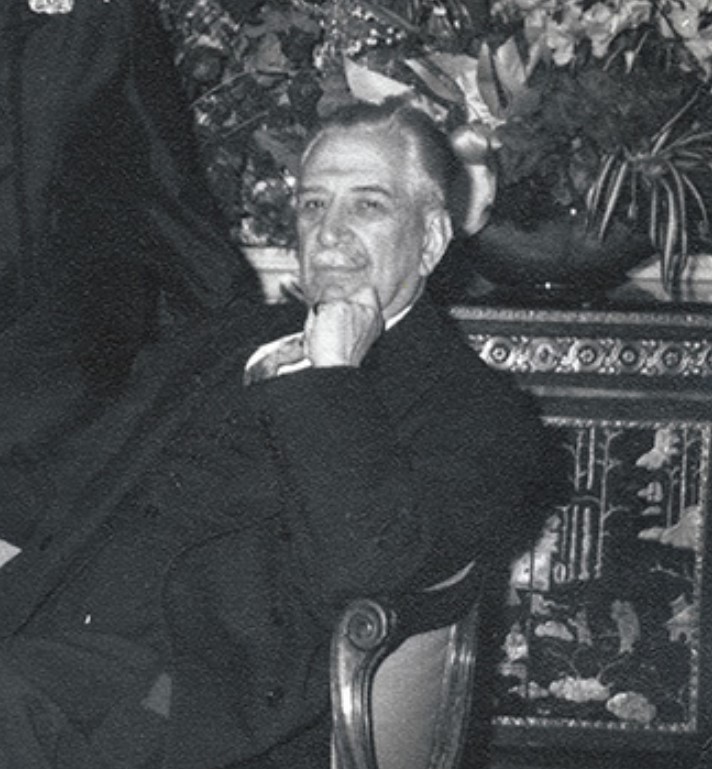
CAILLEUX Paul (EN)
Paul Cailleux was a specialist in 18th century French paintings and drawings and was active as both art dealer and expert. During the Occupation, while his family was threatened by deportation, he carried out transactions with German dealers. Among his clients were the Kaiser Wilhelm Museum in Krefeld and the museum of Düsseldorf. He also sold to Maria Almas-Dietrich, Friedrich Welz, Hildebrand Gurlitt and Bruno Lohse, and provided expertise for the Reichsbank.
An expert accused of being Jewish
Paul de Cayeux de Senarpont1, known as Paul Cailleux, was born 12 November 1884. He worked as an art dealer, opening his gallery rue Laffitte in 1912, moving to 136, rue du Faubourg-Saint-Honoré in 1923.2 His responsibilities included expert-consultant for the government customs administration, expert for the Seine civilan court, administrator and treasurer of the Fédération des commerçants et industries d’art et de qualité (Federation of tradesmen and arts and quality industries), and administrator of the Syndicat des négociants en objets d’art, tableaux et curiosités (Union of dealers in objets d’art, paintings and curiosities).3 He employed a secretary in his gallery, then beginning in 1937 his son Jean and an apprentice. As of June 1940, he lowered the steel grid of his shop,4 after which he dealt only with people who knew he was still in Paris, and who came to him directly.5 For health reasons, Paul Cailleux also hired his son-in-law from 1 April 1942–July 1944.6
His wife, Judith Serf, was Jewish, thus according to German orders, his children and grandchildren were also considered Jewish. They managed to obtain family papers proving “Aryan” ascendancy, however, according to the files of the Roberts Commission, Judith Serf was denounced by Pierre Blanc,7 art dealer in the service of the Sicherheitsdienst and close to Otto Abetz.8 She was arrested on 19 September1942, then released on the following 31 October,9 thanks to the interventions of de Redke,10 of Bruno Lohse,11 and of Walter Bornheim.12
A rumor was being spread by the newspaper La Gerbe that Cayeux was a camouflage name for Cohen.13 A defamation campaign in the form of satire aimed at Paul Cayeux was spread by the count of Chastenet de Puységur,14 for which Cailleux lodged a complaint on 23 October 1944. He and his wife were arrested on 3 December 1943, to be sent to Drancy.15 Once again Bornheim intervened, and they were released.16
Sales and expertise
At the request of Dr Heinrich Wolff, Margot Jansson made use of his expertise in 1941.1 Cailleux also intervened as expert along with Jules Féral and Louis Guiraud – the former being an expert at the International Chamber of Commerce and the latter, expert for the sale of two paintings attributed to François Boucher.2 He again appeared along with Henri Verne, in the context of Boucher paintings belonging to Édouard Larcade and intended for the collection of Hans Wendland through the intermediary of Walter Hofer in 1942.3
Cailleux appears in the reports of the American Commission for the Protection and Salvage of Artistic and Historic Monuments in War Areas (Roberts Commission) as having sold to the Germans minor 18th c. paintings and is presented as a collaborator.4 He also appears in the Schenker Reports as a seller to German museums.5
One of his most important clients was probably the Kaiser Wilhelm Krefeld museum: the Roberts Commission report mentions several sales.6 First, that of 3 March 1941 of the Jeune Femme en bleu (Young woman in blue) by Pierre Bernard for 35,000 F,7 Portrait de M. Abel-François Poisson de Vandières, marquis de Marigny, directeur général des Bâtiments du Roi (1727-1781) by Jean-François de Troy for 200,000 F,8 and Femme allaitant (Woman nursing) par Jean-Laurent Mosnier pour 60 000 F.9 Traces remain of a sale having taken place on 28 March 1941 of a Portrait de Madame de la Marinière by Alexis-Simon Belle for 250,000 F, a pastel representing a young woman by Antoine Coypel for 250,000 F, a family portrait by Marguerite Gérard for 120,000 F and a portrait of a man by Heinsius for 60,000 F.10 Again for the Krefeld museum, he sold a Portrait de Madame de La Sablonnière et sa fille by Alexis-Simon Belle for 12,500 RM,11 and Nina chantant la romance (Nina singing the lovesong) after Henri-Nicolas van Gorp (considered at the time like a Femme à la mandoline de Louis-Léopold Boilly) for the sum of 300,000 F.12 He sold to Friedrich Muthmann, who also bought for the Kaiser Wilhelm de Krefeld museum, two paintings on 5 November 1942,13 which may have been a Portrait de Voltaire for 7,500 F, and Quatre personnages dont une femme chantant dans un parc (Four persons, one a woman singing in a park) attributed to Marguerite Gérard.
Another important German client was Maria Almas-Dietrich.14 According to the files of the Munich Central Collecting Point, she bought, for Hitler, a painting by François Boucher and another by Christoph Amberger.15 Among the works returning to France after the war, three were identified as having been sold by Cailleux to Dietrich for the Linz museum: Le Christ et la femme adultère by Giandomenico Tiepolo, 20 May 1941, as well as the Portrait de l’artiste tenant un crayon à la main (Portrait of the artist holding a pencil) by Johann Ernst Heinsius and Le Grand Pont ou Le Torrent (The Big Bridge or The Torrent) par Hubert Robert, for 100,000 F and 350,000 F, respectively, on 4 July 1941.16
The Düsseldorf museum also acquired from the galerie Cailleux a painting by Hubert Robert, Paysage montagneux, les gorges d’Ollioules (Landscape with mountains, Ollioules valleys) for 300,000 F on 10 July 1941, and one by Charles-Joseph Natoire, Portrait de Louis-Anne de Bourbon Condé, Mademoiselle de Charolais for a million francs on 25 August 1943.17 Through the intermediary of Adolf Wüster, Cailleux sold Femme en source of Nicolas de Largillierre for 50,000 F on 7 April 1942, resold by Wüster to the Düsseldorf museum on 4 July1942. Wüster also bought from Cailleux the Autoportrait à la palette by François-André Vincent, intended for the collection of Joachim von Ribbentrop, for over a million francs.18
On 9 October 1940, Cailleux sold Friedrich Welz a series of four 16th c. tapestries on the labors of Hercules for the sum of 425,000 F, intended for the Salzburg Landesgalerie.19 In addition, he sold for Hildebrandt Gurlitt through the intermediary of Theodor Hermsen20 and for Gustav Rochlitz, Hermann Kundt and the Reichsbank through the intermediary of Heinrich Wolff.21 One witness indicated to the American services that several times, Cailleux proposed art works to Bruno Lohse pour Hermann Göring, for the sake of a cordial relationship with him. However, according to the interrogation of Lohse, Cailleux, not wanting to make such sales, demanded prohibitive prices22 and as a result, none were ever concluded between the two men.23 Other names appear in his network during the Occupation – the maison Jansen, Serge Mons, Ernest Garin, Margot Jansson and Jean Cassagne.24
The “aryanisation” of Jewish property
As he was director of the Syndicat des négociants en objets d’art, tableaux et curiosités (Union of dealers in objets d’art, paintings and curiosities), the Commissariat aux questions juives questioned him on the names of the dealers noted in his repertoire, in the aim of making Cailleux an administrator for the liquidation of the enterprises of dealers in modern art1 and to name managers for the sequestered “Israelite firms”.
Cailleux met with thirty-odd colleagues and invited them to accept to manage the Jewish firms.2 In that way he participated directly in the “aryanisation” of these businesses, but justified his position arguing the protection of the firms’ patrimony, made possible thanks to being supervised by the managers attributed to them.3 In February 1942 he was summoned by colonel Kurt von Behr, head of the service for the confiscation of Jewish property (ERR), who asked him, as president of the Union, to demand that his colleagues furnish a list of objects in their hands belonging to Jews.4
This request had already been made to André Schoeller, president of the Syndicat des éditeurs d’art et négociants en tableaux modernes (Union of art publishers and dealers in modern painting) and was refused by him.5 After concertation with Paul Véroudart, president of the Comité d’organisation des antiquaires, he explained having got round the request, arguing that in the profession, his union was non-exclusive. He sent von Behr to the Comité d’organisation des antiquaires.6
Summoned to the Comité de confiscation
Cailleux was summoned before the Comité de confiscation des profits illicites for expertise of paintings for the Reichsbank, as well as for the sale of paintings to the Düsseldorf museum. He was imposed a confiscation fee of 833,800 F and a fine of one million francs.1
For his defense, Cailleux pointed out the Jewish origins of his wife, the fact that he had housed and protected various persons during the Occupation, notably André Serf2 and capitaine Rheims.3 He also packed approximately fifty cases with his most precious pieces, which he entrusted to friends for protection.4
Cailleux died in 1964. The galerie Cailleux was taken over by his son, Jean, and existed until 2000. Since then, the gallery’s file has been conserved in the library of the Institut national d’histoire de l’art, with sales listed by artist’s name.
Basic data
Personne / personne




